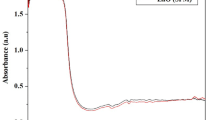Abstract
To test the impact of commercial nanomaterials on the environment and biological species, the potential eco-toxicity of nano sized silver powder was investigated with bacteria, Gram-negative Escherichia coli and Gram-positive Bacillus subtilis and yeast, Saccharomyces cerevisiae. When commercial silver nanopowder was dispersed in water, it was shown to contain both silver nanoparticles and silver ions. S. cerevisiae showed a higher survival rate than the other two species. To compare the antimicrobial activity as a quantitative parameter, the susceptibility constant was determined. The susceptibility constant of the silver ions were larger than those of the silver nanopowder. On average, the degree of susceptibility to silver decreased in the following order, E. coli > B. subtilis > S. cerevisiae.
Similar content being viewed by others
References
Thill, A., O. Zeyons, O. Spalla, F. Chauvat, J. Rose, M. Auffan, and A. M. Flank (2006) Cytotoxicity of CeO2 nanoparticles for Escherichia coli. physico-chemical insight of the cytotoxicity mechanism. Environ. Sci. Technol. 40: 6151–6156.
Ok-Jae, S., K. Chun-Kwang, and R. Jong Il (2008) Immobilization of glucose oxidase and lactate dehydro genase onto magnetic nanoparticles for bioprocess monitoring system. Biotechnol. Bioprocess Eng. 13: 716–723.
Nel, A., T. Xia, L. Madler, and N. Li (2006) Toxic potential of materials at the nanolevel. Science 311: 622–627.
Barnard, A. S. (2006) Nanoharzards: knowledge is our first defence. Nat. Mater. 5: 245–248.
Jeon, H. J., S. C. Yi, and S. G. Oh (2003) Preparation and antibacterial effects of Ag-SiO2 thin films by sol-gel method. Biomaterials 24: 4921–4928.
Sondi, I. and B. Salopek-Sondi (2004) Silver nanoparticles as antimicrobial agent: a case study on E. coli as a model for Gram-negative bacteria. J. Colloid Interface Sci. 275: 177–182.
Lok, C. N., C. M. Ho, R. Chen, Q. Y. He, W. Y. Yu, H. Sun, P. K-H. Tam, J. F. Chiu, and C. M. Che (2006) Proteomic analysis of the mode of antibacterial action of silver nanoparticles. J. Proteome Res. 5: 916–924.
Russell, A. D. and W. B. Hugo (1994) Antimicrobial activity and action of silver. Prog. Med. Chem. 31: 351–370.
Olson, M. E., J. B. Wright, K. Lam, and R. E. Burrell (2000) Healing of porcine donor sites covered with silver-coated dressings. Eur. J. Surg. 166: 486–489.
Bosetti, M., A. Masse, E. Tobin, and M. Cannas (2002) Silver coated materials for external fixation devices: in vitro biocompatibility and genotoxicity. Biomaterials 23: 887–892.
Hollinger, M. A. (1996) Toxicological aspects of topical silver pharmaceuticals. Crit. Rev. Toxicol. 26: 255–260.
Simon, V. A., G. H. Niall, and R. Stefania (1996) Copper toxicity towards Saccharomyces cerevisiae: dependence on plasma membrane fatty acid composition. Appl. Environ. Microbiol. 62: 3960–3966.
Lee, S. H., I. S. Oh, Y. I. Kim, S. C. Jun, S. S. So, and H. G. Kim (2007) Phellinus extracts inhibit migration and matrix metalloproteinase secretion in porcine coronary artery endothelial cells. Biotechnol. Bioprocess Eng. 12: 100–105.
Montaser, A. and D. W. Golightly (1992) Inductively Coupled Plasmas in Analytical Atomic Spectrometry. pp. 361–398. VCH Publishers, Inc., NY, USA.
Covington, A. K. (1993) Introduction: basic electrode types, classifications, and selectivity considerations. pp. 1–20. In: A. K. Covington (ed.). Ion Selective Electrode Methodology. CRC Press, Boca Raton, Florida, USA.
Katherine, B. H. and J. B. Allen (2005) Interaction of silver (I) ions with the respiratory chain of Escherichia coli: an electrochemical and scanning electrochemical microscopy study of the antimicrobial mechanism of micromolar Ag+. Biochemistry 44: 13214–13223.
Munich Information Center for Protein Sequences (MIPS), Comprehensive yeast genome database. http://mips.gsf.de.
Yoon, K. Y., J. Hoon Byeon, J. H. Park, and J. Hwang (2007) Susceptibility constants of Escherichia coli and Bacillus subtilis to silver and copper nanoparticles. Sci. Total Environ. 373: 572–575.
Author information
Authors and Affiliations
Corresponding author
Rights and permissions
About this article
Cite this article
Lee, S., Lee, J., Kim, K. et al. Eco-toxicity of commercial silver nanopowders to bacterial and yeast strains. Biotechnol Bioproc E 14, 490–495 (2009). https://doi.org/10.1007/s12257-008-0254-6
Received:
Accepted:
Published:
Issue Date:
DOI: https://doi.org/10.1007/s12257-008-0254-6




